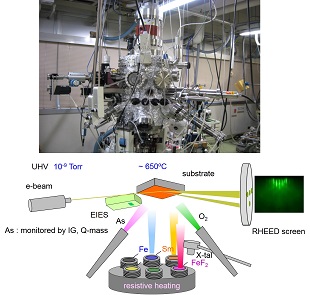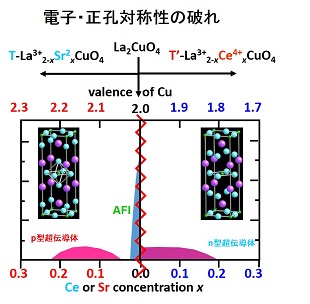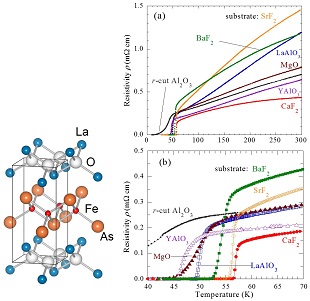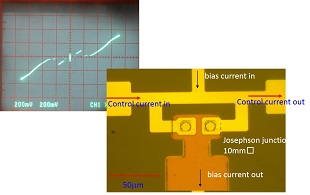分子線エピタキシーで追いかける室温超伝導の「夢」

メンバー: 内藤方夫
分野: 物理学、応用物理学、材料工学
所属: 工学研究院先端物理工学部門
キーワード: 超伝導材料、分子線エピタキシー成長(MBE)、ジョセフソン素子、銅酸化物、MgB2、鉄系超伝導体
ウェブサイト:
研究概要

私たちは分子線エピタキシー成長(Molecular Beam Epitaxy、MBE)を用いた低温合成により、従来のバルク合成では作れない新しい高温超伝導材料を探索しています。最終ゴールは常温でゼロ抵抗となる「室温超伝導体」の発見です。MBEは半導体の単結晶薄膜の成長に使われる最先端ハイテク技術です。この技術を四・五元素からなり、かつ、複雑な構造を持つ化合物の超伝導体に応用するには、各元素の分子線の流量を精密に制御する必要があります。私たちは、分子線流量の精密制御に関しては世界トップの技術を持っており、他研究グループが追随できない高品質単結晶薄膜の成長を可能にしています。私たちのグループが現在手がけている研究を以下に紹介します。
(1)銅酸化物高温超伝導体における「電子・正孔対称性の破れ」
現在までに最高のTc~140Kを持つ銅酸化物超伝導体については、モット絶縁体へのキャリア注入が重要であるとする「強相関モデル」が定説でした。しかし、我々はキャリア注入なしで超伝導となる一群の銅酸化物を発見し、「電子・正孔対称性の破れ」にもとづいて四半世紀にわたる定説を覆しました。
(2)新しい鉄系超伝導材料の開発
2008年に、東工大・細野教授らのグループが磁性元素の鉄を含む超伝導材料が発見しました。従来、磁性と超伝導は「犬猿の仲」でしたから、この発見は世界中を驚かせました。鉄系超伝導体のTcは~55Kで銅酸化物には及ばないものの、強磁場中でも超伝導が壊れないなど応用上の利点を有することが報告されています。我々はMBE法により五元系の鉄系超伝導材料SmFeAs(O,F)の高品質薄膜の成長を世界に先駆けて達成しました。
(3)MgB2超伝導デバイス
超伝導素子は極微弱な電磁波を検出できるため、はるかかなたの宇宙から飛来する電波を観測する電波天文学には欠かせない存在になっています。これまでの超伝導素子は液体He温度(4.2K)で動作していますが、Heは希少元素で21世紀中には枯渇すると言われています。我々は、液体H2温度(20K)で動作するMgB2(Tc~40K)素子の開発を行っています。
主要論文・参考事項
1) "One-step growth of SmFeAs(O,F) films by molecular beam epitaxy using FeF2 as a fluorine source", H. Sugawara, T. Tsuneki, .D Watanabe, A. Yamamoto, M. Sakoda, and M. Naito, Superconductor Science and Technology 28 (2015) 015005.
2) "Optical study of superconducting Pr2CuOx with x≃ 4", G. Chanda, R. P. S. M. Lobo, E. Schachinger, J. Wosnitza, M. Naito, and A. V. Pronin, Physical Review B 90 (2014) 024503.
3) "Emerging superconductivity hidden beneath charge-transfer insulators", Y. Krockenberger, H. Irie, O. Matsumoto, K. Yamagami, M. Mitsuhashi, A. Tsukada, M. Naito, and H. Yamamoto, Scientific Reports 3 (2013) 2235.
4) "Unconventional transport and superconducting properties in electron-doped cuprates", Y. Krockenberger, H. Yamamoto, A. Tsukada, M. Mitsuhashi, and M. Naito, Physical Review B 85 (2012) 184502.
5) "Growth of superconducting SmFeAs(O, F) epitaxial films by F diffusion", S. Takeda, S. Ueda, S. Takano, A. Yamamoto, and M. Naito, Superconductor Science and Technology 25 (2012) 035007.
6) "High-Tc and high-Jc SmFeAs(O,F) films on fluoride substrates grown by molecular beam epitaxy", S. Ueda, S. Takeda, S. Takano, A. Yamamoto, and M. Naito, Applied Physics Letters 99 (2011) 232505.
7) "Simple Route to Grow High-Quality MgB2 Thin Films by Pyrolysis of Decaborane (B10H14) in Mg Vapor", M. Naito, A. Yamamoto, S. Ueda, and K. Nishiyuki, Applied Physuics Express 4 (2011) 073101.
8) "Synthesis and properties of superconducting T'-R2CuO4 (R=Pr, Nd, Sm, Eu, Gd)", O. Matsumoto, A. Utsuki, A. Tsukada, H. Yamamoto, T. Manabe, and M. Naito, Physical Review B 81 (2010) 099904.
9) "Generic phase diagram of "electron-doped" T' cuprates", O. Matsumoto, A. Utsuki, A. Tsukada, H. Yamamoto, T. Manabe, and M. Naito, Physica C 469 (2009) 924-927.
10) "Superconductivity in undoped T'-RE2CuO4 with Tc over 30 K", O. Matsumoto, A. Utsuki, A. Tsukada, H. Yamamoto, T. Manabe, and M. Naito, Physica C 468 (2008) 1148-1151.
お問い合わせ先
東京農工大学・先端産学連携研究推進センター
urac[at]ml.tuat.ac.jp([at]を@に変換してください)
Pursuing the dream of room-temperature superconductors by molecular beam epitaxy

Research members: Dr. Michio Naito
Research fields: Physics, Applied physics, Material engineering
Departments: Division of Advanced Applied Physics, Institute of Engineering
Keywords: superconductors, molecular beam epitaxy, Josephson junctions, copper oxide superconductors, MgB2, Fe-based superconductors
Web site:
Summary

We have been performing the search for new superconducting materials based on our unique molecular beam epitaxy (MBE) technique, which enables low-temperature synthesis of materials that cannot be reached by conventional bulk synthesis. Our final goal is the discovery of room-temperature superconductors, which become zero resistance at ambient temperatures. MBE is a hi-tech thin-film growth method, which has been utilized in the semiconductor field over decades, for example, in growing epitaxial films of GaAs. In order to apply this technique to much more complicated superconducting materials consisting of 4 to 5 elements than GaAs, the precise control of each beam flux of constituent elements is prerequisite. We are on the leading edge in this respect, and have established the state-of-the-art technique based on spectroscopic methods such as atomic absorption or emission spectrometry. This enables us to grow overwhelming-quality epitaxial films of complex oxides, nitrides, pnictides, etc. The following researches are under way in our group.
(1) Broken electron-hole symmetry in high-Tc copper oxides
It has been believed for a long time that high-Tc superconductivity in copper oxides is achieved by career doping into parent antiferromagnetic Mott insulator. However, we have found that the parent compounds with the Nd2CuO4 (so-called T’) structure, having square-planar oxygen coordination, become superconducting without doping. Our finding points to broken electron-hole symmetry in high-Tc copper oxides and disproves the above scenario for high-Tc superconductivity.
(2) MBE growth of recently discovered Fe-based superconductors
In 2008, Hosono group in Tokyo Institute of Technology, discovered Fe-based superconductor with Tc reaching 55 K. This discovery has astonished superconductor researchers since superconductivity and magnetism compete in the conventional BCS theory and the inclusion of Fe usually depresses Tc. Fe-based superconductors have higher upper critical fields (Hc2) than copper oxides, especially in magnetic fields parallel to superconducting FeAs layers, in spite of their lower Tc. This makes these materials promising for superconductor cable application. Our group has succeeded in growing high-quality epitaxial films SmFeAs(O,F) with Tc = 58 K exceeding the bulk value.
(3) MgB2 devices
Superconducting devices are the most sensitive heterodyne receivers in the 100 GHz to 1000 GHz frequency range, and hence are used for radio astronomy at these frequencies. Current superconducting devices are made of Nb and operate at 4.2 K (liquid He temperature). However, helium is an element that is scarce in the Earth and is predicted to exhaust in the 21st century. Therefore our group is developing superconducting devices made of MgB2 (Tc~40K) that operate at 20 K (liquid H2 temperature).
Reference articles and patents
1) "One-step growth of SmFeAs(O,F) films by molecular beam epitaxy using FeF2 as a fluorine source", H. Sugawara, T. Tsuneki, .D Watanabe, A. Yamamoto, M. Sakoda, and M. Naito, Superconductor Science and Technology 28 (2015) 015005.
2) "Optical study of superconducting Pr2CuOx with x≃ 4", G. Chanda, R. P. S. M. Lobo, E. Schachinger, J. Wosnitza, M. Naito, and A. V. Pronin, Physical Review B 90 (2014) 024503.
3) "Emerging superconductivity hidden beneath charge-transfer insulators", Y. Krockenberger, H. Irie, O. Matsumoto, K. Yamagami, M. Mitsuhashi, A. Tsukada, M. Naito, and H. Yamamoto, Scientific Reports 3 (2013) 2235.
4) "Unconventional transport and superconducting properties in electron-doped cuprates", Y. Krockenberger, H. Yamamoto, A. Tsukada, M. Mitsuhashi, and M. Naito, Physical Review B 85 (2012) 184502.
5) "Growth of superconducting SmFeAs(O, F) epitaxial films by F diffusion", S. Takeda, S. Ueda, S. Takano, A. Yamamoto, and M. Naito, Superconductor Science and Technology 25 (2012) 035007.
6) "High-Tc and high-Jc SmFeAs(O,F) films on fluoride substrates grown by molecular beam epitaxy", S. Ueda, S. Takeda, S. Takano, A. Yamamoto, and M. Naito, Applied Physics Letters 99 (2011) 232505.
7) "Simple Route to Grow High-Quality MgB2 Thin Films by Pyrolysis of Decaborane (B10H14) in Mg Vapor", M. Naito, A. Yamamoto, S. Ueda, and K. Nishiyuki, Applied Physuics Express 4 (2011) 073101.
8) "Synthesis and properties of superconducting T'-R2CuO4 (R=Pr, Nd, Sm, Eu, Gd)", O. Matsumoto, A. Utsuki, A. Tsukada, H. Yamamoto, T. Manabe, and M. Naito, Physical Review B 81 (2010) 099904.
9) "Generic phase diagram of "electron-doped" T' cuprates", O. Matsumoto, A. Utsuki, A. Tsukada, H. Yamamoto, T. Manabe, and M. Naito, Physica C 469 (2009) 924-927.
10) "Superconductivity in undoped T'-RE2CuO4 with Tc over 30 K", O. Matsumoto, A. Utsuki, A. Tsukada, H. Yamamoto, T. Manabe, and M. Naito, Physica C 468 (2008) 1148-1151.
Contact
University Research Administration Center(URAC),
Tokyo University of Agriculture andTechnology
urac[at]ml.tuat.ac.jp
(Please replace [at] with @.)


